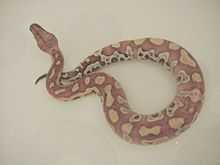Python curtus brongersmai
| Python brongersmai | |
|---|---|
 | |
| Scientific classification | |
| Kingdom: | Animalia |
| Phylum: | Chordata |
| Subphylum: | Vertebrata |
| Class: | Reptilia |
| Order: | Squamata |
| Suborder: | Serpentes |
| Family: | Pythonidae |
| Genus: | Python |
| Species: | P. brongersmai |
| Trinomial name | |
| Python brongersmai KEOGH, BARKER & SHINE, 2001 | |
| Synonyms | |
| |
Python brongersmai, a subspecies python, is a non-venomous snake found on the Malay Peninsula.[2]
Geographic range
Peninsular (Western) Malaysia, Sumatra east of the central dividing range of mountains, Bangka Island and other islands in the Strait of Malacca, including the Lingga islands, Riau islands, and Pinang.
Their natural habitat is often marsh and tropical swamps. They are a primarily nocturnal species that is usually active around dawn and dusk.
Size
Hatchlings range from 10” – 17”, Adult males typically range from 36” (3’) – 60” (5’) in length, and females between 48” (4’) – 72” (6’) although a few 96” (8’) have been recorded. These snakes generally look overweight due to their robust structure.
Life Span
Most experts agree that they will live 20+ years in captivity if proper care is given.
Coloration
The color pattern consists of rich, bright red to orange to a duller rusty red ground color, although populations with yellow and brown are known. This is overlaid with yellow and tan blotches and stripes that run the length of the body, as well as tan and black spots that extend up the flanks. The belly is white, often with small black markings. The head is usually a shade of grey; individual snakes can change how light and dark the head is. A white postocular stripe runs down and back from the posterior edge of the eye.
Reproduction
Oviparous, with up to 30 eggs being laid at a time. The female coil around her eggs and shivers her body, producing heat to incubate the eggs properly.
Uses
Once widely considered to be generally unpredictable and aggressive, these snakes are gradually becoming more common among herpetoculturists. Formerly, many of the specimens in captivity were wild-caught adults from Malaysia. These are known to be more aggressive than those from Indonesia (Sumatra), from which most of the wild-caught, wild-bred, and captive-bred stock are now descended. Captive-raised juveniles generally become mild-tempered, somewhat-predictable adults. This, combined with several new brightly colored captive bloodlines, is helping to boost the popularity of these much-maligned snakes among reptile hobbyists.[citation needed]
The snake is part of a commercial harvest for leather.[3]
Taxonomy
The subspecies was first described by Olive Griffith Stull in 1938.[4] The group has since been elevated and recognised as a full species by Pauwels et al. (2000).[3][5]
See also
- List of pythonid species and subspecies.
- Pythonidae by common name.
- Pythonidae by taxonomic synonyms.
References
- ↑ McDiarmid RW, Campbell JA, Touré T. 1999. Snake Species of the World: A Taxonomic and Geographic Reference, vol. 1. Herpetologists' League. 511 pp. ISBN 1-893777-00-6 (series). ISBN 1-893777-01-4 (volume).
- ↑ "Python curtus brongersmai". Integrated Taxonomic Information System. Retrieved 12 September 2007.
- ↑ 3.0 3.1 Keogh, J. S.; Barker, D. Shine, R. (2001). "Heavily exploited but poorly known: systematics and biogeography of commercially harvested pythons (Python curtus group) in Southeast Asia (abstract)". Biological Journal of the Linnean Society 73 (1): 113. doi:10.1111/j.1095-8312.2001.tb01350.x.
- ↑ Stull, O.G. 1938. Three New Subspecies of the Family Boidae. Occ. Pap. Boston Soc. Nat. Hist., 8: 297-300.
- ↑ Python brongersmai at the Reptarium.cz Reptile Database. Accessed 15 September 2007.
Further reading
- Barker, Dave and Tracy (November 2007). "Blood Pythons," Reptiles Magazine. Bowtie Publishing.
External links
| Wikimedia Commons has media related to Python brongersmai. |
- Herp Radio at Herp Herp Hooray. Accessed 15 January 2013.
- Blood Python Care at Bloody Pythons By: David Weimert. Accessed 15 January 2013.